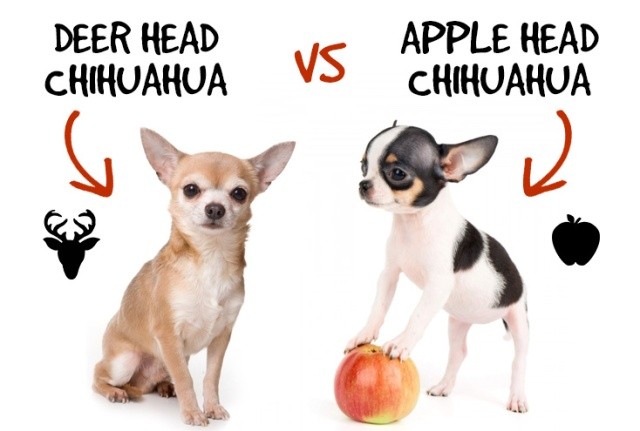
The distinction between apple head and deer head Chihuahuas represents one of the most fascinating examples of selective breeding in domestic dogs. While the American Kennel Club (AKC) only officially recognizes "apple dome" skull shape in breed standards, both variants persist in the breed population. The key anatomical differences lie in the skull structure - apple heads feature a rounded dome skull with a 90-degree angle between muzzle and forehead, while deer heads have an elongated face with a gentler 45-degree slope. Understanding these morphological variations provides crucial insights into canine genetics and the effects of artificial selection on cranial development.
Apple Head vs Deer Head Chihuahuas
Skull Shape Differences
According to breed experts, apple head Chihuahuas feature a rounded, dome-shaped skull with a 90-degree angle between the muzzle and forehead. In contrast, deer head Chihuahuas have a longer, more angular face with a gradual 45-degree slope where the muzzle meets the forehead. The apple head's short muzzle and prominent forehead results in more bulging eyes, while deer heads have less pronounced eyes due to their elongated facial structure.
Health Considerations
Studies show deer head Chihuahuas tend to have fewer health issues compared to apple heads. The apple head's shortened facial structure makes them more prone to respiratory problems like reverse sneezing and tracheal collapse. Additionally, apple heads frequently have moleras (soft spots on the skull) that may never fully close, requiring extra care when handling. Dental and eye issues are also more common in apple head varieties due to their compressed facial anatomy.
Physical Characteristics and Differences Between Apple Head vs Deer Head Chihuahuas
Body Structure and Size Variations
While the previous sections covered skull differences and health aspects, this section focuses on overall physique. According to breed experts, apple head Chihuahuas typically have shorter legs and necks, giving them a more compact "cobby" body structure. In contrast, deer head Chihuahuas feature longer limbs and necks, resulting in a more proportionate appearance. Size-wise, deer heads tend to be slightly larger, sometimes weighing up to 12 pounds, while apple heads generally stay under 6 pounds.
Ear and Neck Characteristics
Research shows deer head Chihuahuas have larger ears set higher on the head compared to apple heads. Their longer necks contribute to a more graceful appearance. Apple head varieties display smaller, more proportionate ears relative to their compact heads and shorter necks, creating a more rounded overall profile.
Health Differences and Breed Standards Between Apple Head vs Deer Head Chihuahuas
Breed Recognition and Show Standards
While both types are purebred Chihuahuas, research indicates that only apple head Chihuahuas meet the American Kennel Club's official breed standard requiring a "well rounded apple dome skull." This means deer head Chihuahuas cannot compete in conformation shows, though they can still be AKC registered if their parents are registered. The breed standard also specifies apple heads should maintain under 6 pounds in weight.
Genetic Health Implications
Building on previous health discussions, studies show the compressed skull shape of apple heads can lead to hydrocephalus (water on the brain) due to their dome-shaped cranium. The abrupt angle between their snout and skull also increases dental problems due to overcrowding. While deer heads can experience typical small breed health issues, their more natural skull structure reduces their risk of these specific conformational problems.
Behavioral and Temperament Distinctions
Training and Socialization Patterns
According to breed experts, while both varieties require early socialization, deer head Chihuahuas often display more relaxed temperaments and adaptable personalities compared to apple heads. However, trainability depends more on individual dogs and early training rather than head shape. Studies indicate both types need consistent positive reinforcement training methods to overcome typical small dog behavioral tendencies.
Historical Development
Research shows archaeological evidence suggests both head shapes existed in pre-Columbian Central America, indicating this variation emerged before European contact. Some experts theorize deer heads resulted from crossing the ancient Techichi dog with Chinese Crested breeds, while apple heads descended directly from the Techichi, though definitive proof remains elusive. This early divergence helps explain why both types persist in modern breeding programs.
Conclusion
The research reveals significant anatomical, health, and breed recognition differences between apple head and deer head Chihuahuas. Apple heads feature a distinctive 90-degree angle between muzzle and forehead with a rounded dome skull, while deer heads have a more gradual 45-degree slope and longer facial structure. These physical differences have important health implications - apple heads are more prone to respiratory issues, dental problems, and skull abnormalities due to their compressed facial anatomy, while deer heads generally experience fewer health complications due to their more natural skull structure.
While only apple head Chihuahuas meet AKC breed standards for show competitions, both varieties are purebred Chihuahuas with ancient origins tracing back to pre-Columbian Central America. Deer heads tend to be slightly larger with longer limbs and necks, often displaying more relaxed temperaments, though individual personality varies more by upbringing than head shape. These findings suggest that potential Chihuahua owners should carefully consider these physical and health differences when choosing between the varieties, with deer heads potentially being a healthier choice for those not focused on show standards.